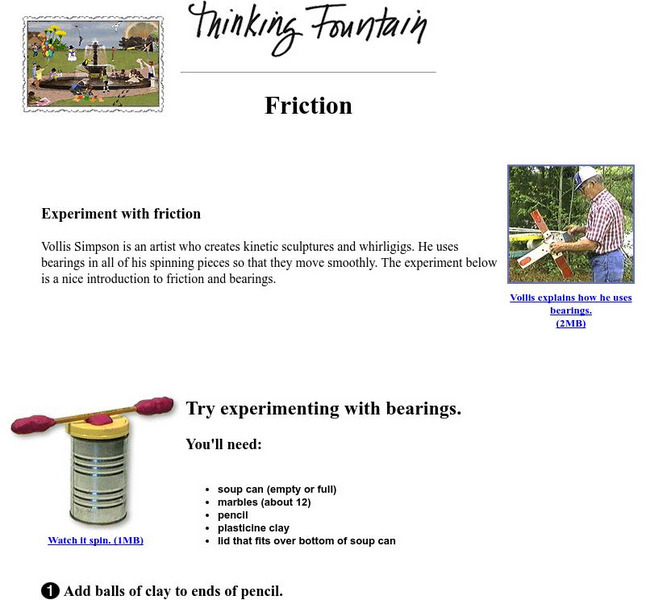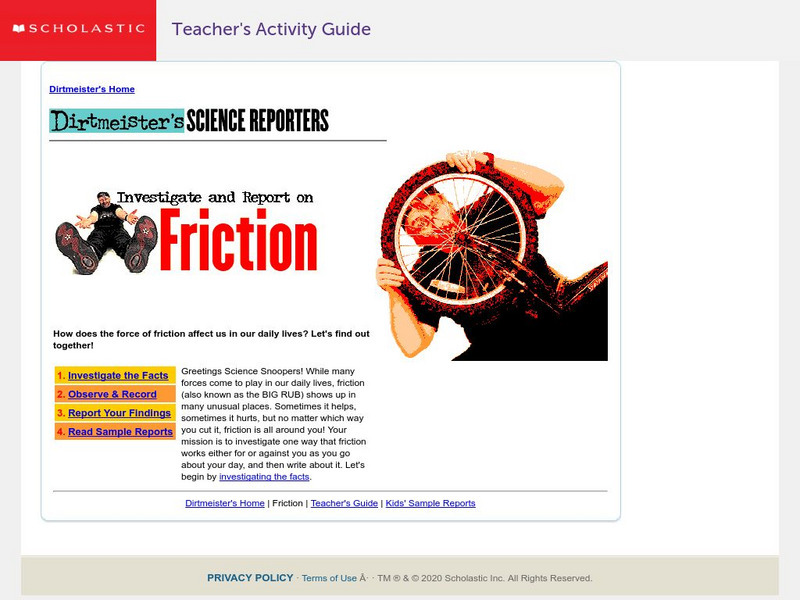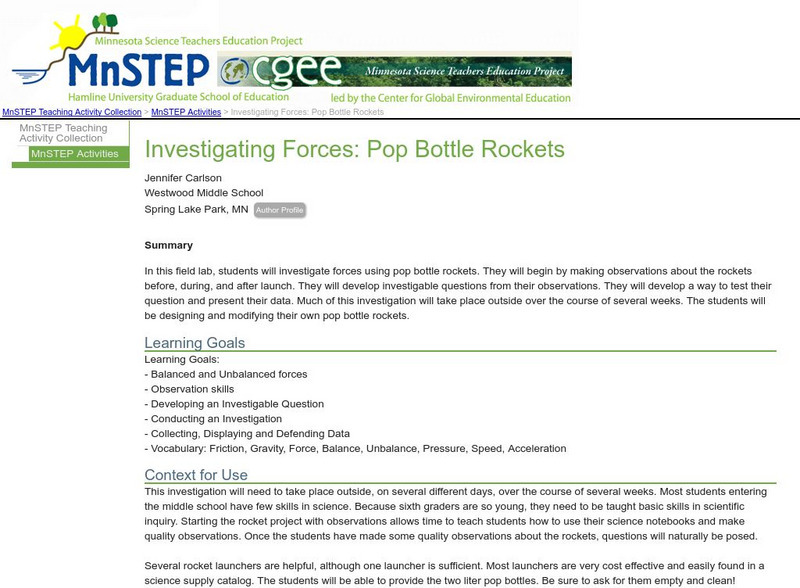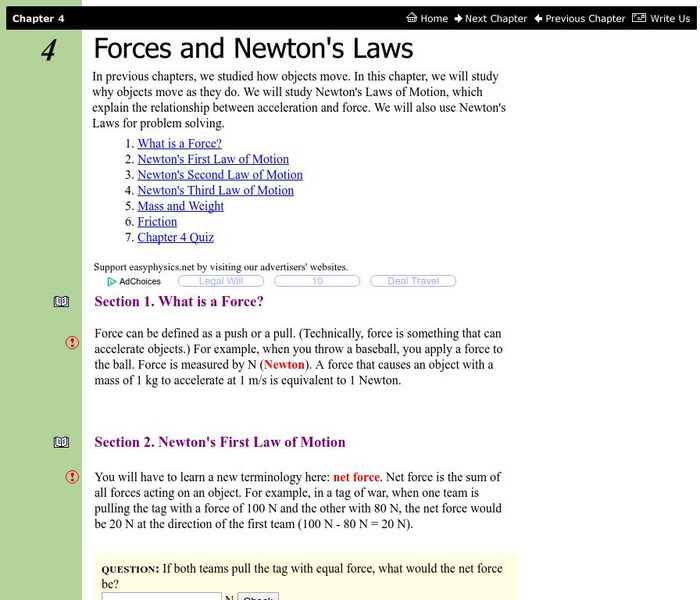Children's Museum
The Children's Museum of Indianapolis: Build a Parachute
Young scholars create a parachute to explore how air pushes up against an object and slows it down as it falls.
Science Buddies
Science Buddies: How Does a Hovercraft Hover?
In this activity, you will get to build your own mini hovercraft. How will different amounts of air in the balloon affect how long the hovercraft hovers?
Massachusetts Institute of Technology
Mit: Open Course Ware: Force and Potential Energy
The activity investigates conservation of energy. Some topics explored are friction, kinetic energy, conservation of energy, and potential energy. The resource consists of video clips, lecture notes, practice problems, and exam...
Georgia State University
Georgia State University: Hyper Physics: Air Friction
Physics lab definition of air fiction. Part of a hypertext physics course on sound.
PBS
Pbs Learning Media: A Bright Idea
A Bright Idea shows several different power sources and asks students to write about friction, electricity, combustion or light.
Science Museum of Minnesota
Thinking Fountain: Friction
This science experiment provides a nice introduction to friction and bearings.
Scholastic
Scholastic: Dirtmeister's Science Reporters: Simple Machines: The Wheel and Axle
An in-depth explanation of the wheel and axle from Scholastic. Also provides several examples and a picture for understanding.
Scholastic
Scholastic: Dirtmeister's Science Reporters: Friction
Step into Dirtmeister's Science Lab and become a Science Snooper! Work side by side with him as he sets out to answer the challenge question: "How does the force of friction affect us in our daily lives?"
Texas Instruments
Texas Instruments: Friction and Newton's 3rd Law
This activity assesses students' knowledge and understanding of Newton's 3rd Law.
Texas Instruments
Texas Instruments: Frictional Forces
In this activity, students' will use a Dual range force sensor to measure the force required to pull a block across different surfaces. They will examine the results to see when more force is needed to move the block and understand the...
Texas Instruments
Texas Instruments: Friction
Students study how the nature of two materials in contact, and the smoothness of their surfaces affect the magnitude of the sliding force of friction. They use a force sensor to measure frictional force for different surfaces.
Science Education Resource Center at Carleton College
Serc: Newton's Second Law: Constant Force Applied to a Skateboarder
In this lab activity, students will become familiar with Newton's 2nd Law of Motion. By investigating the motion of different skateboarders pulled with a variety of constant force values, they will discover that bodies acted on by a...
Science Education Resource Center at Carleton College
Serc: Investigating Forces: Pop Bottle Rockets
In this lab, students will work on scientific inquiry skills: observation, developing questions, conducting an experiment, and collecting data. They will investigate forces using pop bottle rockets that they have designed.
Science Education Resource Center at Carleton College
Serc: Investigating Gravity: Predicting Time to Hit the Ground
Students will drop and shoot horizontally "Nerf" balls from a variety of known heights then record the amount of time it takes for the ball to hit the ground for each trial. They will plot height vs. time data and create a trend line for...
Science Education Resource Center at Carleton College
Serc: Investigating Projectile Motion: Creating a Catapult
This lesson is for 9th grade physical science students. It begins with an inquiry-based lesson using a projectile motion computer simulation. It culminates with students building a catapult; applying and connecting science knowledge from...
Science Education Resource Center at Carleton College
Serc: Newton's Second: Having a Ball With Motion
Students will create a gravity ball launcher to demonstrate their understanding of mass, force, momentum, and motion. The students will use critical thinking, measurement, and observation and analysis of data to make changes and improve...
Science Education Resource Center at Carleton College
Serc: Investigating Motion: What Causes Objects to Move?
Students will have an opportunity to determine what makes everyday objects move. Students will be given objects and asked to make predictions on how far each object will move after they blow on it. Then they will measure the distance and...
Science Education Resource Center at Carleton College
Serc: Investigating Forces: Balloon Car Activity
In this activity, teams of students build a car out of common materials which is then propelled by the release of air out of a balloon and must travel a minimum distance. The activity is then extended to a competition to build the car...
Science Education Resource Center at Carleton College
Serc: Conservation of Energy of While Rolling Down a Hill
A real-life example of a ball rolling down a ramp to see whether mechanical energy really is conserved when objects roll down hills. Students analyze video clips of children rolling down a driveway on roller blades and various bikes and...
TryEngineering
Try Engineering: Getting Your Bearings
Students learn about teamwork and problem solving in this lesson that focuses on friction and how ball bearings are used to reduce it.
TryEngineering
Try Engineering: Give Me a Brake
Activity investigates the concept of how bicycle brakes use force and friction to stop or slow mechanical motion. Students work in teams to devise a simple braking system while suggesting improvements to current bicycle brake design.
Ohio State University
Ohio State Univ.: Simple Machines & Mechanical Advantage [Pdf]
This site details how simple machines create a mechanical advantage for humans. Levers, theoretical mechanical advantage, actual mechanical advantage, and pulley systems are discussed.
Project Britain
Primary Homework Help: Forces Quiz
First, read some fast facts about forces, then take a ten-question, multiple-choice quiz. Check to see if your answers are correct after each question.
Other
Easyphysics: Chapter 4 Forces
Learners investigate forces and Newton's laws. Some topics examined are mass, friction, and Newton?s laws of motion. The resource includes example problems with solutions and a chapter quiz.



















